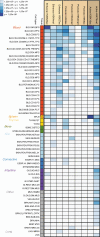GWAS for systemic sclerosis identifies multiple risk loci and highlights fibrotic and vasculopathy pathways
- PMID: 31672989
- PMCID: PMC6823490
- DOI: 10.1038/s41467-019-12760-y
GWAS for systemic sclerosis identifies multiple risk loci and highlights fibrotic and vasculopathy pathways
Abstract
Systemic sclerosis (SSc) is an autoimmune disease that shows one of the highest mortality rates among rheumatic diseases. We perform a large genome-wide association study (GWAS), and meta-analysis with previous GWASs, in 26,679 individuals and identify 27 independent genome-wide associated signals, including 13 new risk loci. The novel associations nearly double the number of genome-wide hits reported for SSc thus far. We define 95% credible sets of less than 5 likely causal variants in 12 loci. Additionally, we identify specific SSc subtype-associated signals. Functional analysis of high-priority variants shows the potential function of SSc signals, with the identification of 43 robust target genes through HiChIP. Our results point towards molecular pathways potentially involved in vasculopathy and fibrosis, two main hallmarks in SSc, and highlight the spectrum of critical cell types for the disease. This work supports a better understanding of the genetic basis of SSc and provides directions for future functional experiments.
Conflict of interest statement
H.Y.C. is a co-founder of Accent Therapeutics and advisor to 10x Genomics and Spring Discovery. All other authors declare no competing interests.
Figures



Comment in
-
New genetic risk loci found for SSc.Nat Rev Rheumatol. 2020 Jan;16(1):4. doi: 10.1038/s41584-019-0342-3. Nat Rev Rheumatol. 2020. PMID: 31754243 No abstract available.
References
Publication types
MeSH terms
Grants and funding
LinkOut - more resources
Full Text Sources
Other Literature Sources
Medical

